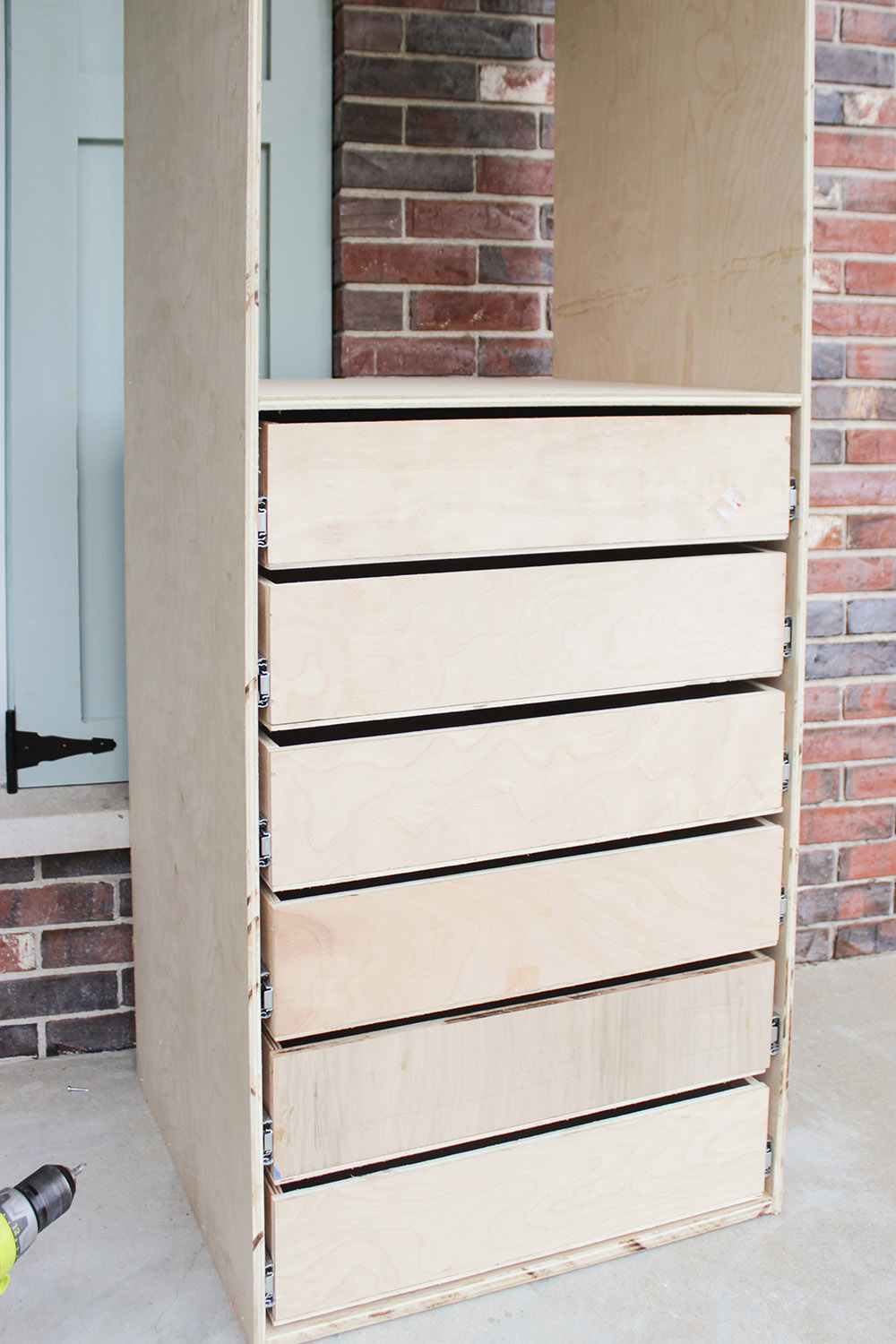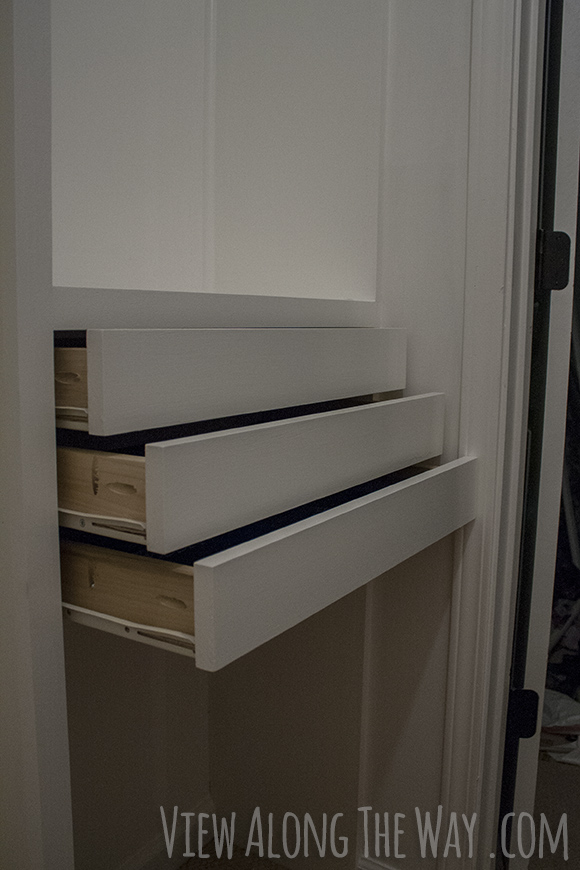To make closet drawers, measure the space, choose materials, build the frame, and install drawer slides. Having closet drawers is a great way to keep your belongings organized and easily accessible.
By following these simple steps, you can create custom drawers that fit perfectly in your closet. Whether you’re a seasoned DIY-er or a beginner, building closet drawers can be a fun and rewarding project. With the right tools and materials, you can transform your closet into a functional and stylish storage solution.
We will guide you through the process of making closet drawers, from planning to installation, so you can enjoy a more organized space in no time.
Choosing The Right Materials
When it comes to making closet drawers, choosing the right materials is essential for ensuring durability and functionality. Quality wood selection, along with reliable drawer slides and hardware, will contribute to a sturdy and long-lasting drawer system.
Quality Wood Selection
Choosing the right type of wood is crucial for the strength and longevity of your closet drawers. Opt for hardwoods such as oak, maple, or birch, as they are known for their durability and resistance to warping or splitting. Avoid softwoods like pine, as they may not withstand heavy use or withstand the weight of your belongings for an extended period.
Keep in mind that solid wood can be quite expensive, but it offers superior quality and aesthetic appeal. If you’re on a budget, consider using plywood or medium-density fiberboard (MDF) for the drawer box construction. These materials are more cost-effective while still offering decent strength.
Drawer Slides And Hardware
The drawer slides and hardware you choose play a significant role in the functionality and ease of use of your closet drawers. There are several types of drawer slides available:
- Ball-bearing slides: These provide smooth and quiet operation, making them ideal for heavy-duty drawers or drawers that will be frequently used. They offer a full extension, allowing you to access the entire drawer contents with ease.
- Side-mount slides: These slides are cost-effective and commonly used for lighter drawers or those with limited depth. However, they provide only three-quarters extension, limiting access to the back portion of the drawer.
- Undermount slides: These concealed slides offer a sleek and seamless appearance. They are suitable for medium-duty drawers and provide full extension. However, installation can be a bit more complex.
Regardless of the slide type you choose, make sure to select slides with a weight rating that exceeds the heaviest items you plan to store in the drawers. This will prevent any strain or damage to the slides over time.
In addition to drawer slides, remember to select durable and easy-to-use hardware such as drawer pulls or knobs. Consider factors like style, size, and ergonomics when choosing these components to ensure they complement the overall design of your closet.

Credit: www.anikasdiylife.com
Designing Your Drawer System
When it comes to designing your drawer system, careful planning is essential for optimizing space and functionality.
Measurements And Space Considerations
- Start by measuring the dimensions of your closet space to determine the available width, height, and depth.
- Consider the items you intend to store in the drawers to ensure they fit comfortably once installed.
- Double-check your measurements to avoid any errors that could affect the final fit of your custom drawers.
Drawer Configuration And Layout
- Determine the number of drawers you need based on your storage requirements and preferences.
- Plan the layout of your drawers according to the frequency of use of the items you will store in them.
- Consider incorporating dividers or organizers to maximize the storage space and keep items neatly arranged.
Constructing The Drawers
Constructing the Drawers: Creating sturdy and functional closet drawers involves precision and attention to detail. The process can be broken down into several key steps to ensure a smooth construction process.
Cutting And Preparing Wood Pieces
- Measure and mark the wood according to the drawer dimensions.
- Cut the pieces using a saw to achieve accurate sizing.
- Sand the edges to remove roughness and ensure a snug fit.
Assembling The Drawer Box
- Begin by arranging the cut pieces to form the drawer box shape.
- Join the sides using wood glue for a strong bond.
- Secure the pieces with screws for added stability.
- Attach the bottom piece to complete the drawer box structure.
Installing The Drawers
Constructing closet drawers involves aligning the sliders, securing them in place, and attaching the drawer fronts to complete the installation process effectively. Placing the drawers is crucial for maximizing storage space and enhancing organization within the closet. Following these steps ensures a seamless drawer construction experience for an organized closet solution.
Installing the Drawers: Positioning and Mounting Drawer Slides To complete the installation of your closet drawers, it’s important to position and mount the drawer slides properly. These slides serve as the foundation for smooth and seamless functionality, allowing your drawers to glide in and out effortlessly. When positioning the drawer slides, start by measuring and marking the desired height for each drawer. Ensure that the measurements are consistent to avoid any unevenness in the final result. Use a level to make sure the slides are perfectly horizontal, allowing the drawers to open and close without any unwanted tilting. Once you have determined the correct position, it’s time to mount the drawer slides. Begin by attaching one side of the slides to the inside of the cabinet, using screws or other suitable fasteners. Make sure to align the slides with your earlier measurements to maintain consistency and balance. Next, it’s time to install the complementary section of the drawer slides onto the sides of each drawer. Take care to position these slides accurately, ensuring a snug fit against the cabinet slides. The slides should be placed parallel to one another for smooth movement. Testing and Adjusting the Fit After positioning and mounting the drawer slides, it’s essential to test the fit and make any necessary adjustments. This step ensures that your closet drawers will slide effortlessly and securely. Begin by carefully inserting a drawer into the cabinet, ensuring it glides smoothly along the mounted slides. Take note of any resistance or misalignment during this initial test. If the drawer doesn’t slide smoothly, you may need to adjust the positioning of the slides or slightly sand the edges of the drawer for a better fit. To further fine-tune the fit, check for gaps between the drawer and the cabinet when it is closed. If there are any noticeable gaps, adjust the position of the slides accordingly. It’s essential to address these issues early on to avoid any future problems or potential damage to the drawer or cabinet. By properly positioning and mounting the drawer slides and testing the fit, you’ll ensure that your closet drawers not only look great but also function flawlessly. So take your time during this installation process to achieve the best results possible.Adding Finishing Touches
Adding the finishing touches to your DIY closet drawers is essential to give them a polished and professional look. Whether you’re sanding and smoothing the edges for a seamless finish or applying stain or finish to enhance the aesthetic appeal, these final steps will elevate the overall presentation of your closet drawers.
Sanding And Smoothing Edges
Sanding and smoothing the edges of your closet drawers is crucial to achieving a smooth and professional finish. Start by using sandpaper to gently sand the edges, ensuring that any rough or uneven surfaces are smoothed out. Take care to round off the corners for a neat and polished appearance. After sanding, use a fine-grit sandpaper to further smoothen the edges, creating a seamless transition between the different sections of the drawer.
Applying Stain Or Finish
After ensuring that the edges are perfectly smooth, the next step is to apply stain or finish to enhance the overall look of your closet drawers. Prior to application, ensure that the surface is clean and free from any dust or debris. Use a stain applicator or brush to apply the stain evenly across the surface of the drawers, allowing it to penetrate the wood for a rich and deep color. Finish the process with a layer of clear finish to add durability and protection to the wood, giving your closet drawers a professional and long-lasting finish.
Organizing And Utilizing Space
When it comes to making the best use of your closet space, organizing and utilizing space efficiently is essential. One effective way to achieve this is by incorporating closet drawers. Not only do drawers help to keep your belongings organized, but they also optimize the storage capacity of your closet. Let’s delve into some valuable insights on how to effectively organize and utilize space in your closet by making and utilizing closet drawers.
Drawer Organization Techniques
Organizing your closet drawers is crucial to ensure that you can access your belongings easily and efficiently. Start by categorizing items and allocating specific drawers for each category. Utilize dividers or small storage containers within the drawers to further segregate items. Consider using drawer organizers or dividers to keep items like socks, undergarments, and accessories neatly separated and easily accessible. Labeling the drawers can also help in locating items quickly without having to rummage through each drawer.
Maximizing Storage Efficiency
Maximizing storage efficiency in your closet drawers involves making the most of the available space. Consider utilizing drawer inserts and dividers to create compartments for specific items, maximizing the use of vertical space within the drawers. Choose space-saving drawer systems that are stackable or modular, enabling you to customize the drawer layout according to your storage needs. Additionally, use transparent or clear drawer organizers to easily identify the contents of each drawer, further enhancing accessibility and convenience.
Maintenance And Care
Proper maintenance and care are essential to ensure the longevity and functionality of your closet drawers. By taking a few simple steps, you can keep your drawers clean and address any wear and tear that may occur over time. In this section, we will discuss cleaning and regular inspection, as well as how to address common issues such as wear and tear.
Cleaning And Regular Inspection
Regular cleaning and inspection of your closet drawers will help prevent dirt and grime buildup and catch any potential issues before they become major problems. Here are some steps to follow:
- Start by removing all items from the drawer.
- Wipe down the interior of the drawer with a damp cloth to remove any dust or debris.
- If there are any stains or spills, use a mild soap and water solution to spot clean the affected area.
- Allow the drawer to dry completely before putting the items back in.
- Next, inspect the drawer for any loose or damaged hardware, such as handles or drawer slides.
- If you notice any loose hardware, tighten the screws or bolts accordingly.
- If there are damaged or broken parts, make a note of them for repair or replacement.
Addressing Wear And Tear
Over time, your closet drawers may show signs of wear and tear. It’s important to address these issues promptly to prevent further damage. Here are some tips:
- If you notice any cracks or splits in the drawer material, consider using wood filler to fill the gaps.
- Sand down any rough edges or splinters to create a smooth surface.
- For drawers that are not sliding smoothly, check the drawer slides for dirt or debris. Clean them with a soft brush or cloth.
- If the drawer slides are damaged, consider replacing them with new ones.
- Apply a furniture wax or lubricant to the drawer slides for smoother operation.
- If the drawer bottoms are sagging or weak, reinforce them with additional supports or consider replacing them.
By following these maintenance and care tips, you can ensure that your closet drawers remain in excellent condition for years to come. Regular cleaning and inspection will help prevent issues, and addressing wear and tear promptly will prolong the life of your drawers. With just a little effort, you can keep your closet organized and functional!

Credit: www.youtube.com
Enhancing Drawer Functionality
Incorporating Divider Systems
Implementing divider systems ensures optimal organization within the closet drawers. Utilize dividers to separate clothing items, accessories, or other belongings for enhanced efficiency.
Utilizing Drawer Accessories
Maximize the utility of closet drawers by incorporating accessories such as drawer organizers, trays, and inserts. These accessories aid in categorizing and arranging items neatly.

Credit: www.homedepot.com
Frequently Asked Questions Of How To Make Closet Drawers
How Can I Build Custom Closet Drawers?
To build custom closet drawers, start by measuring the space, selecting the right materials, and using proper tools. Assemble the drawers according to the measurements and install them securely in the closet.
What Are The Essential Materials For Closet Drawers?
You will need wood boards, drawer slides, screws, wood glue, a drill, and a saw to build closet drawers. Ensure the materials are durable and suitable for the specific size and weight requirements.
Can I Customize The Design Of My Closet Drawers?
Absolutely! You can personalize the design of your closet drawers by choosing different wood finishes, adding drawer knobs or handles, and incorporating dividers or compartments for organization.
How Do I Ensure The Closet Drawers Are Securely Installed?
To ensure the closet drawers are securely installed, carefully follow the manufacturer’s guidelines for installing the drawer slides, use suitable hardware, and double-check the measurements and alignment during the installation process.
Conclusion
To sum up, creating closet drawers is a practical and cost-effective way to maximize storage space and keep your belongings organized. By following these step-by-step instructions, you can easily customize and install drawers in your closet. Remember to measure accurately, choose durable materials, and take your time during the construction process.
With a little effort and creativity, you can transform your cluttered closet into a functional and efficient storage solution. Happy DIY-ing!
{ “@context”: “https://schema.org”, “@type”: “FAQPage”, “mainEntity”: [ { “@type”: “Question”, “name”: “How can I build custom closet drawers?”, “acceptedAnswer”: { “@type”: “Answer”, “text”: “To build custom closet drawers, start by measuring the space, selecting the right materials, and using proper tools. Assemble the drawers according to the measurements and install them securely in the closet.” } } , { “@type”: “Question”, “name”: “What are the essential materials for closet drawers?”, “acceptedAnswer”: { “@type”: “Answer”, “text”: “You will need wood boards, drawer slides, screws, wood glue, a drill, and a saw to build closet drawers. Ensure the materials are durable and suitable for the specific size and weight requirements.” } } , { “@type”: “Question”, “name”: “Can I customize the design of my closet drawers?”, “acceptedAnswer”: { “@type”: “Answer”, “text”: “Absolutely! You can personalize the design of your closet drawers by choosing different wood finishes, adding drawer knobs or handles, and incorporating dividers or compartments for organization.” } } , { “@type”: “Question”, “name”: “How do I ensure the closet drawers are securely installed?”, “acceptedAnswer”: { “@type”: “Answer”, “text”: “To ensure the closet drawers are securely installed, carefully follow the manufacturer’s guidelines for installing the drawer slides, use suitable hardware, and double-check the measurements and alignment during the installation process.” } } ] }
